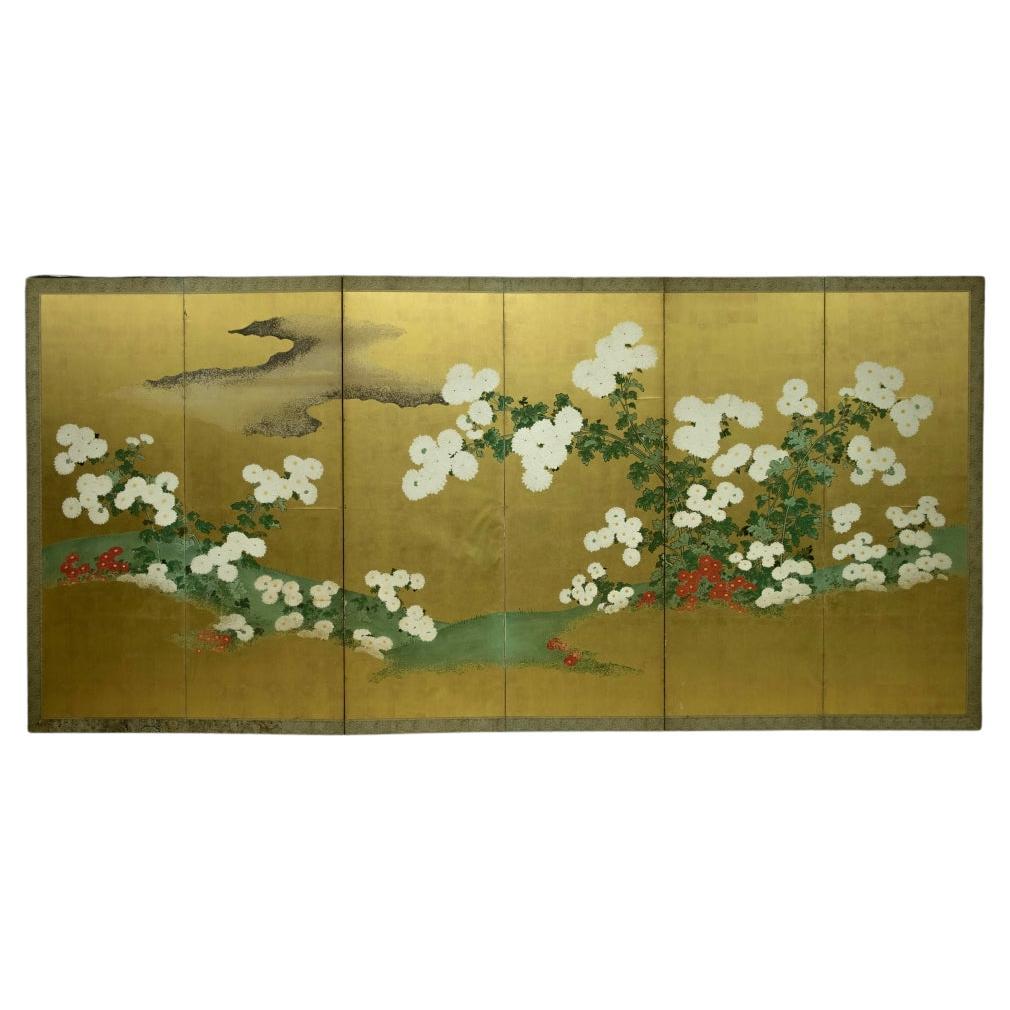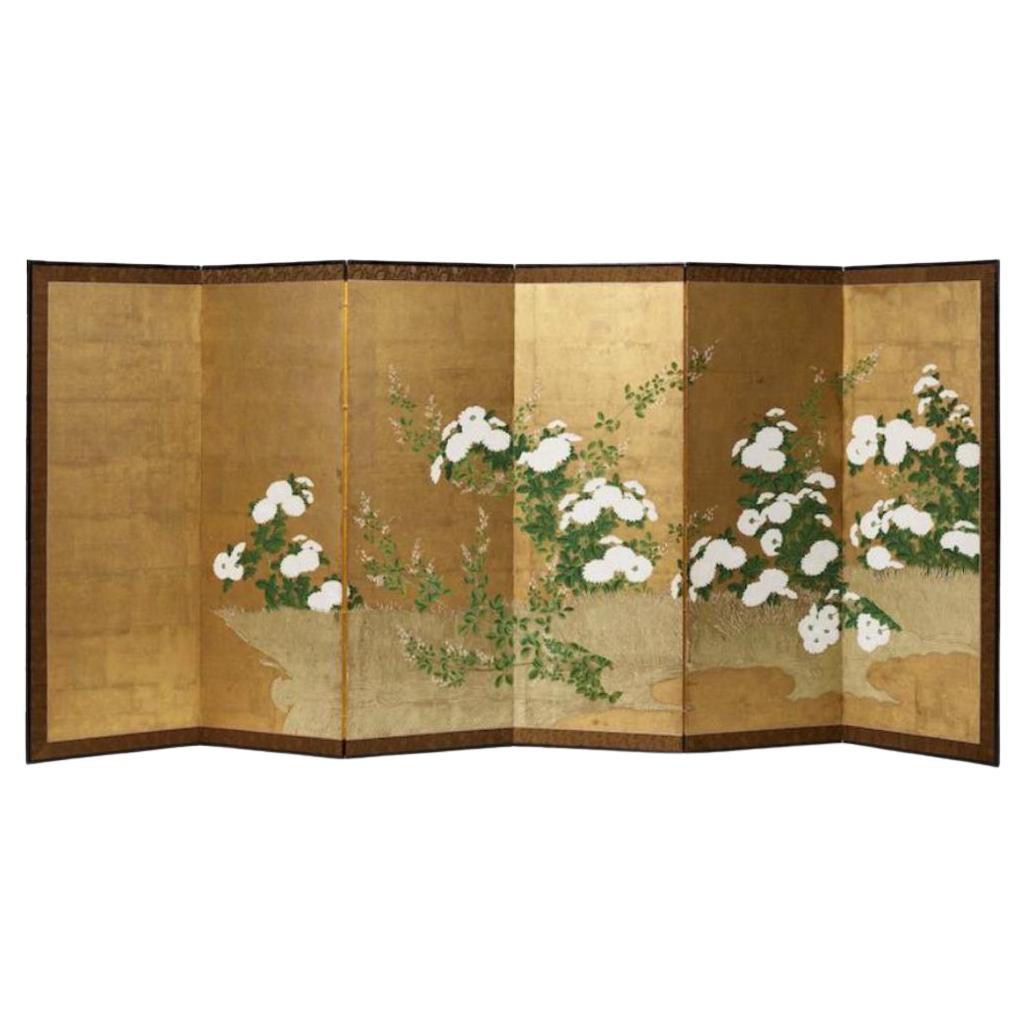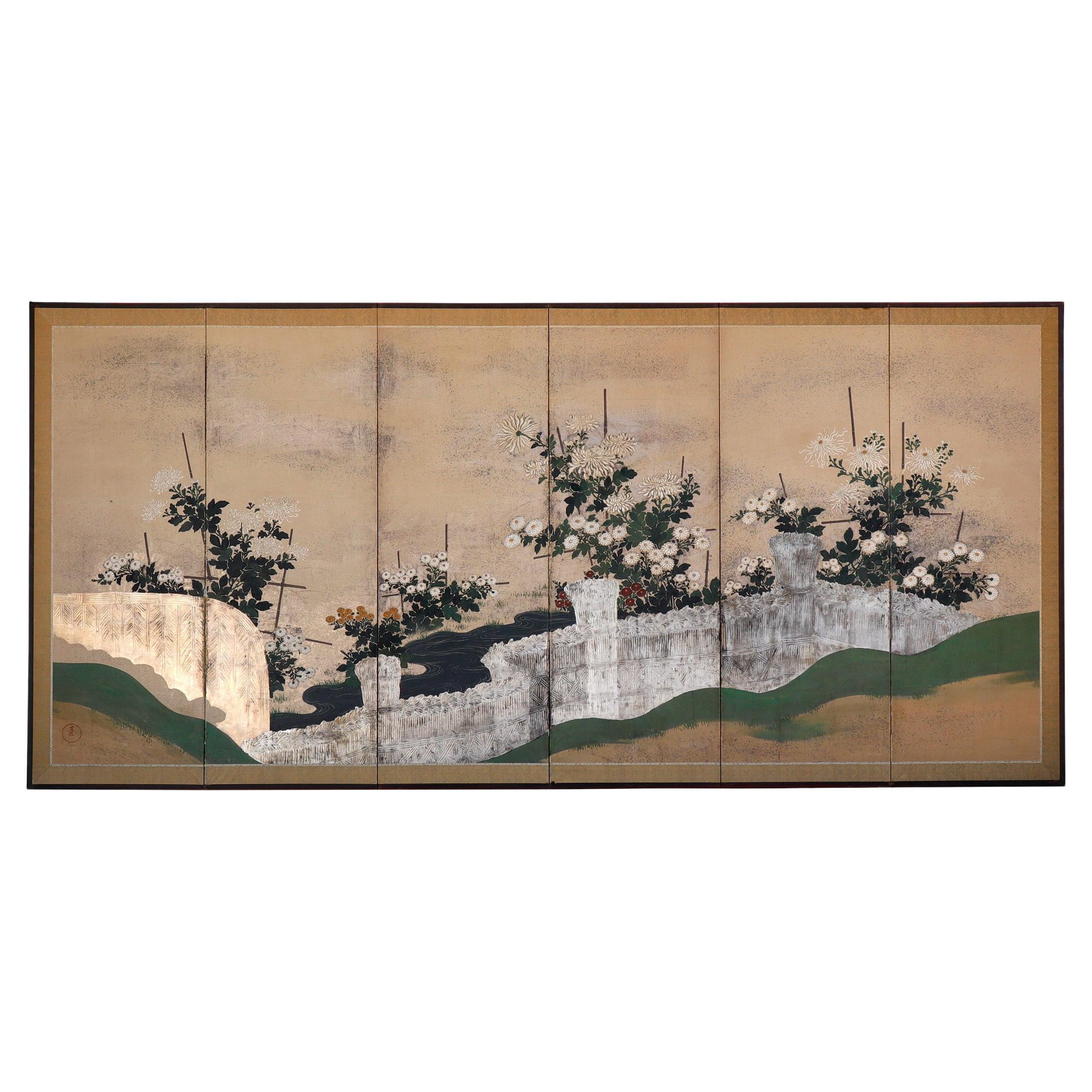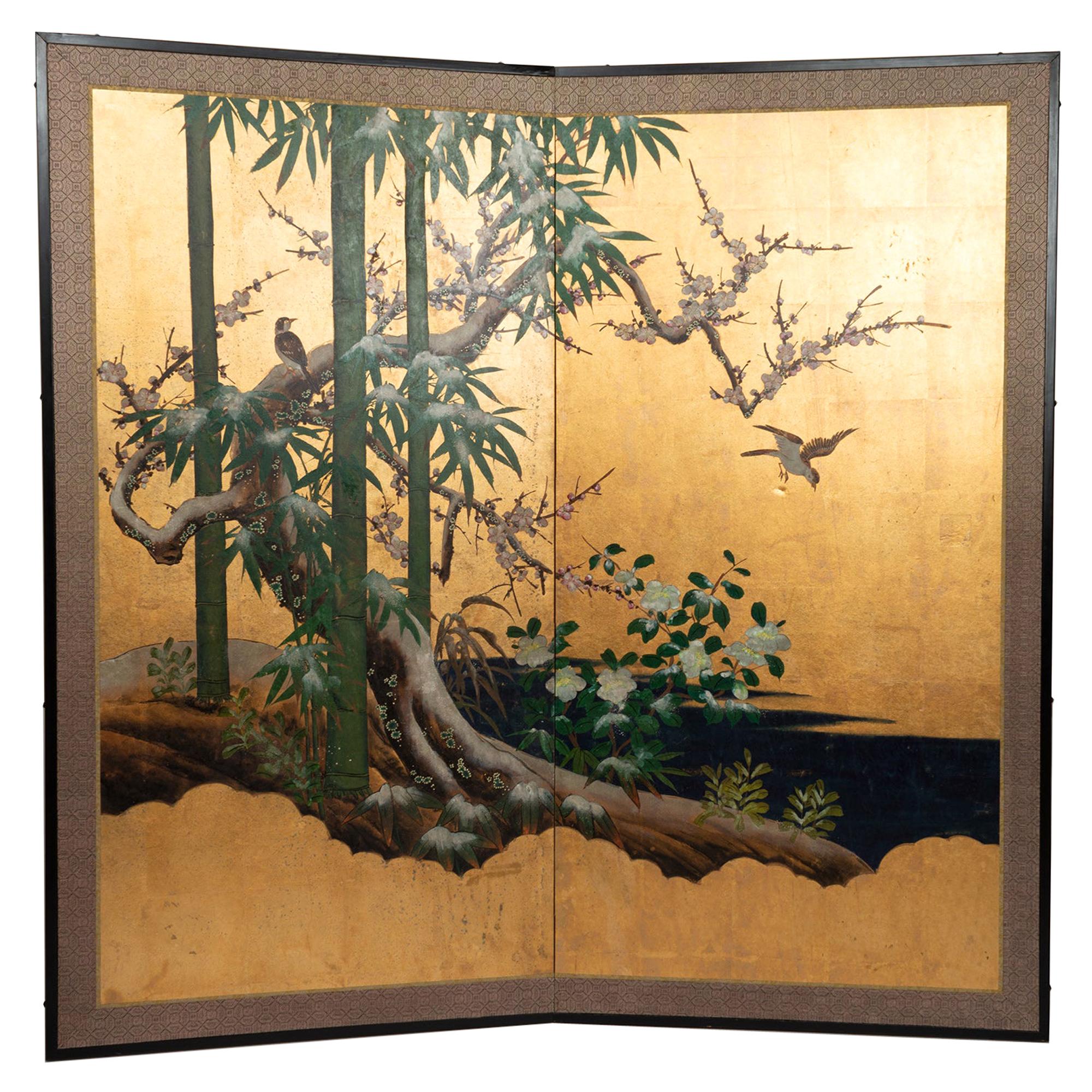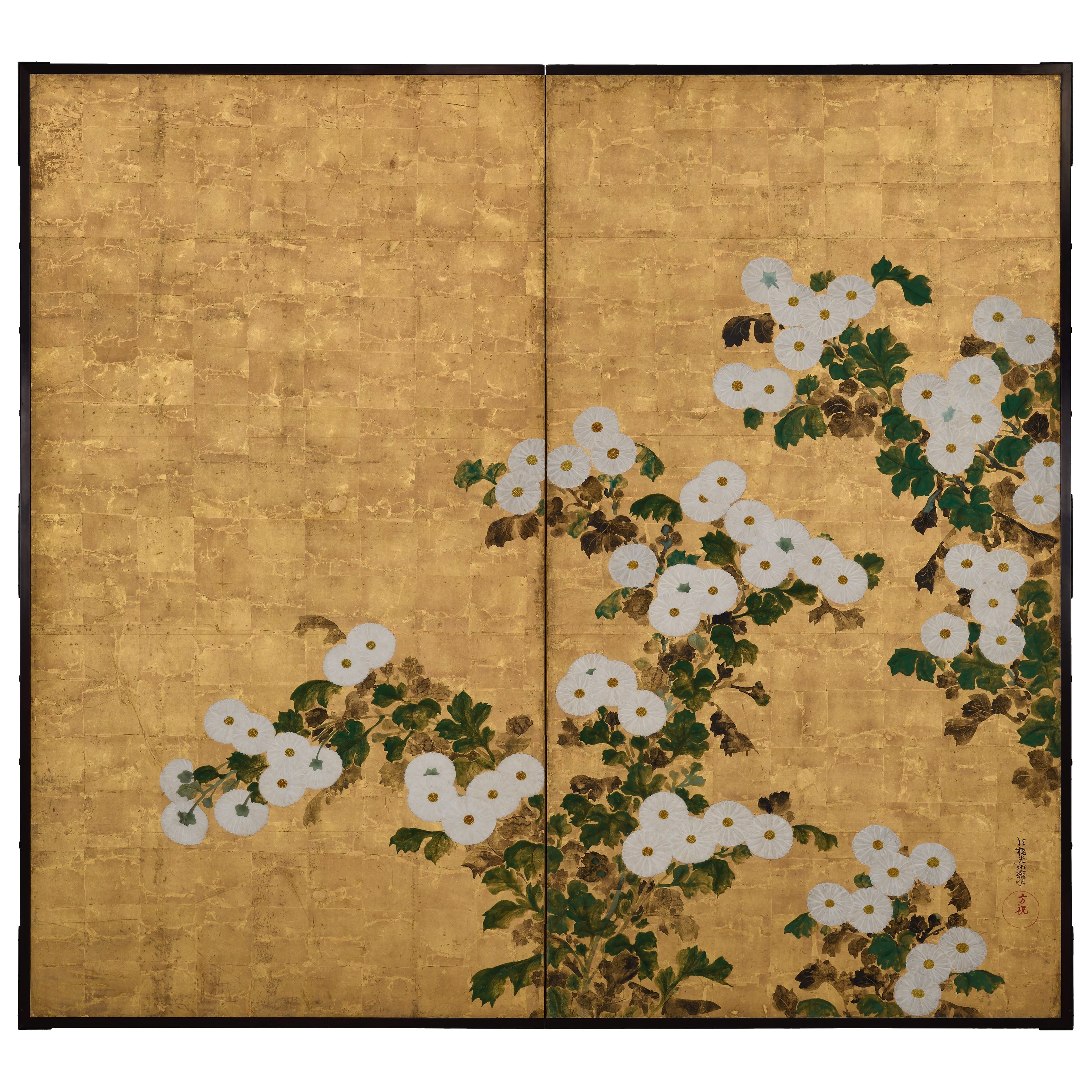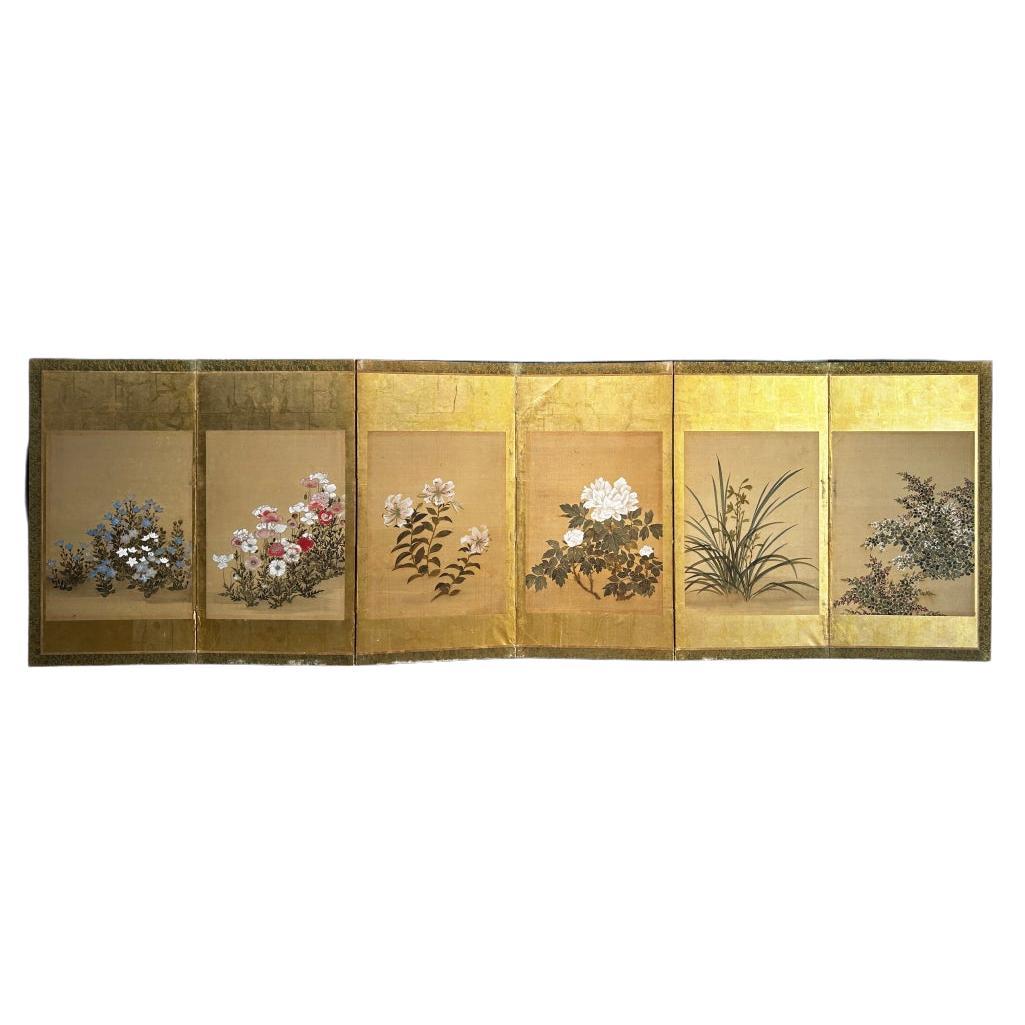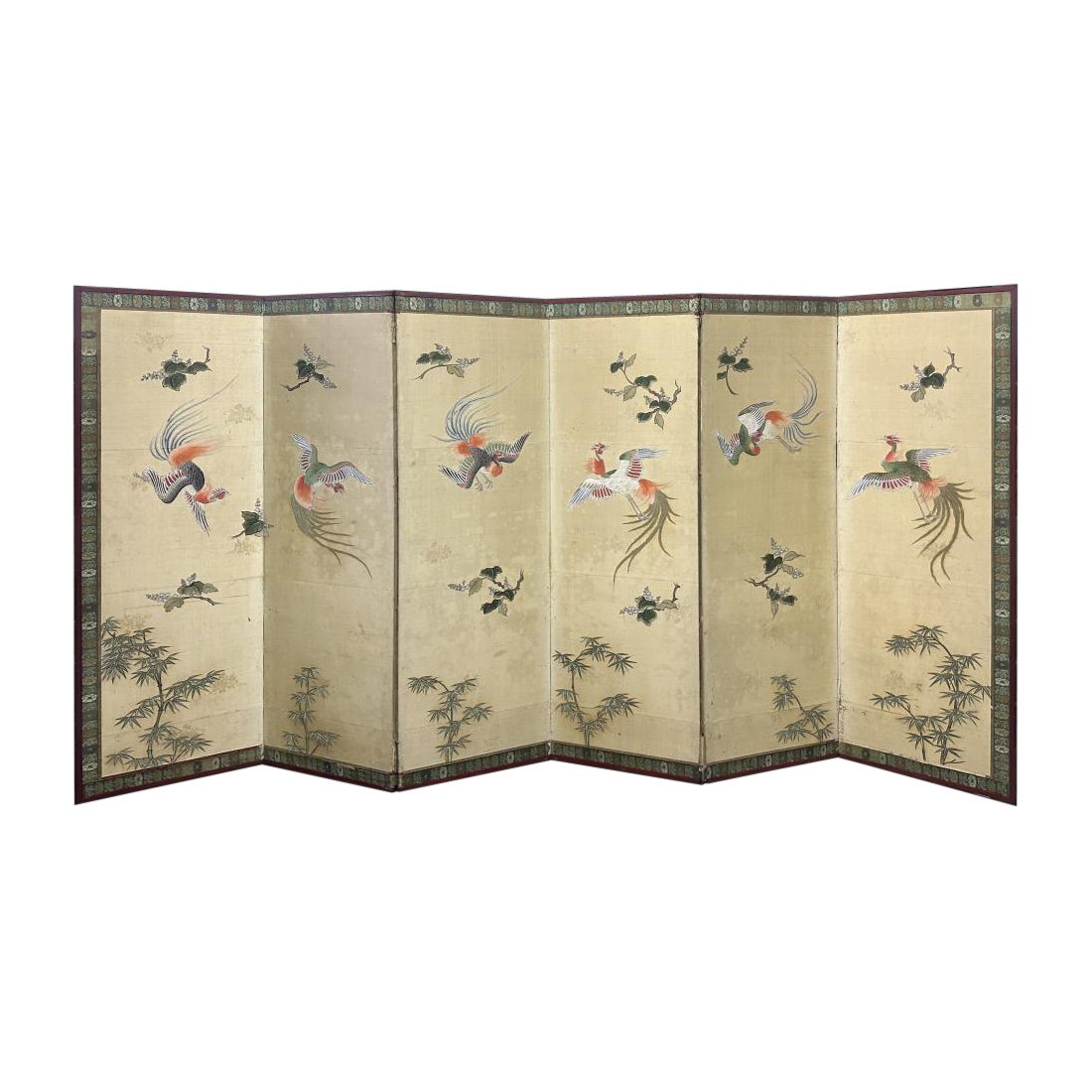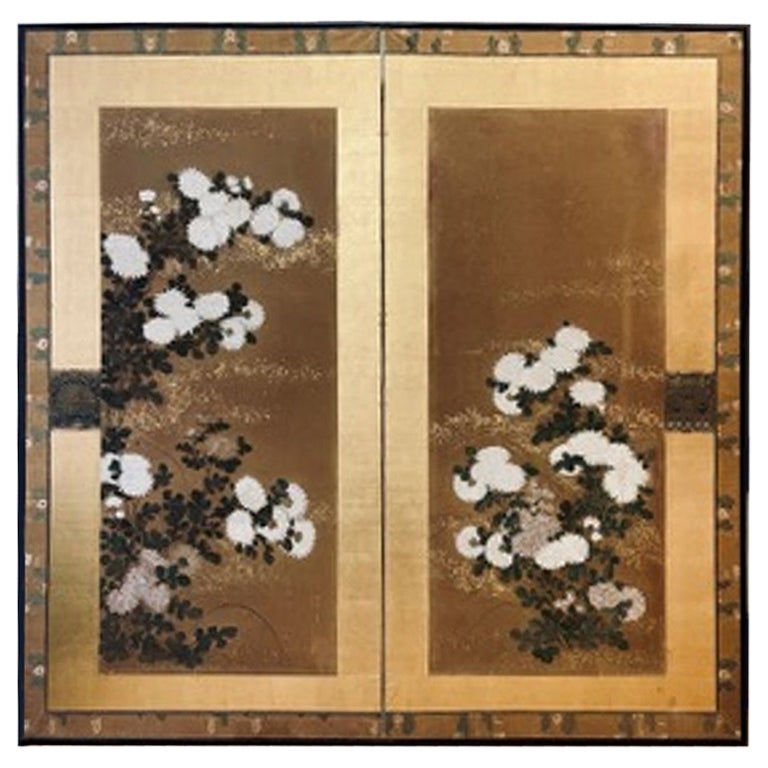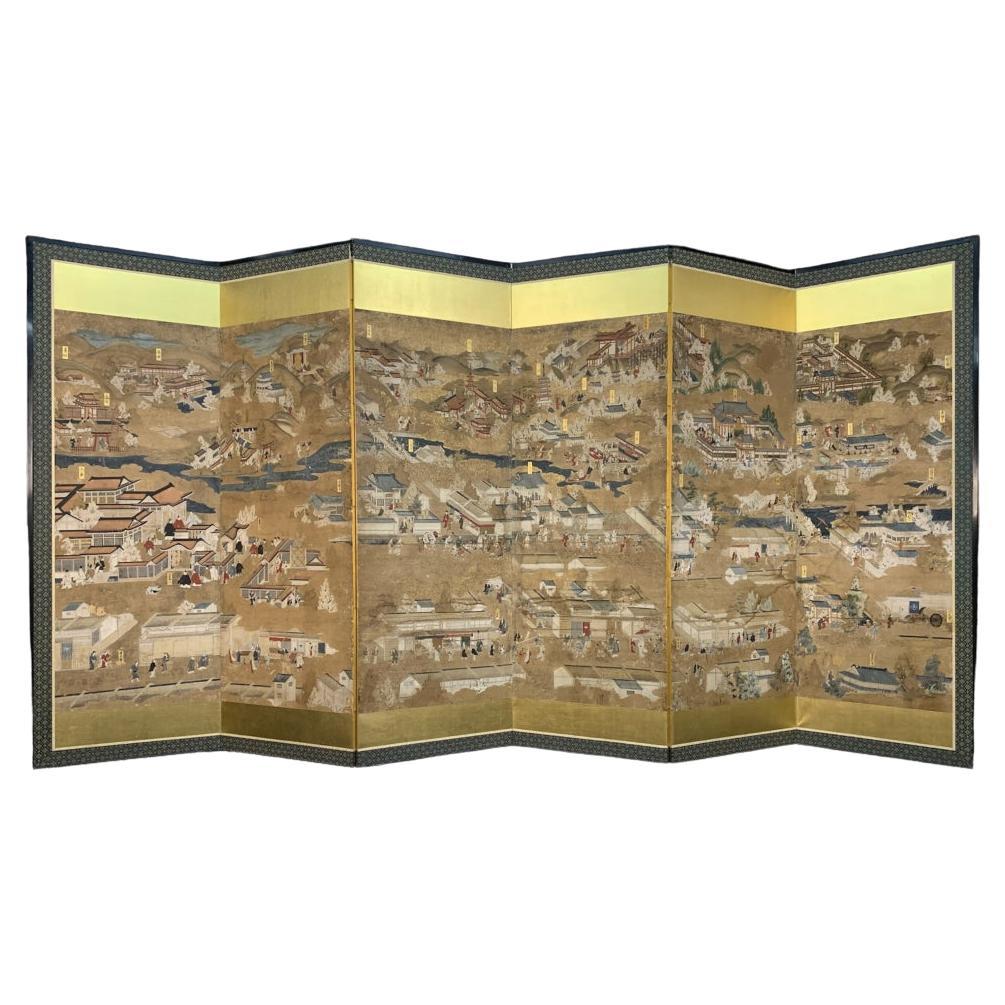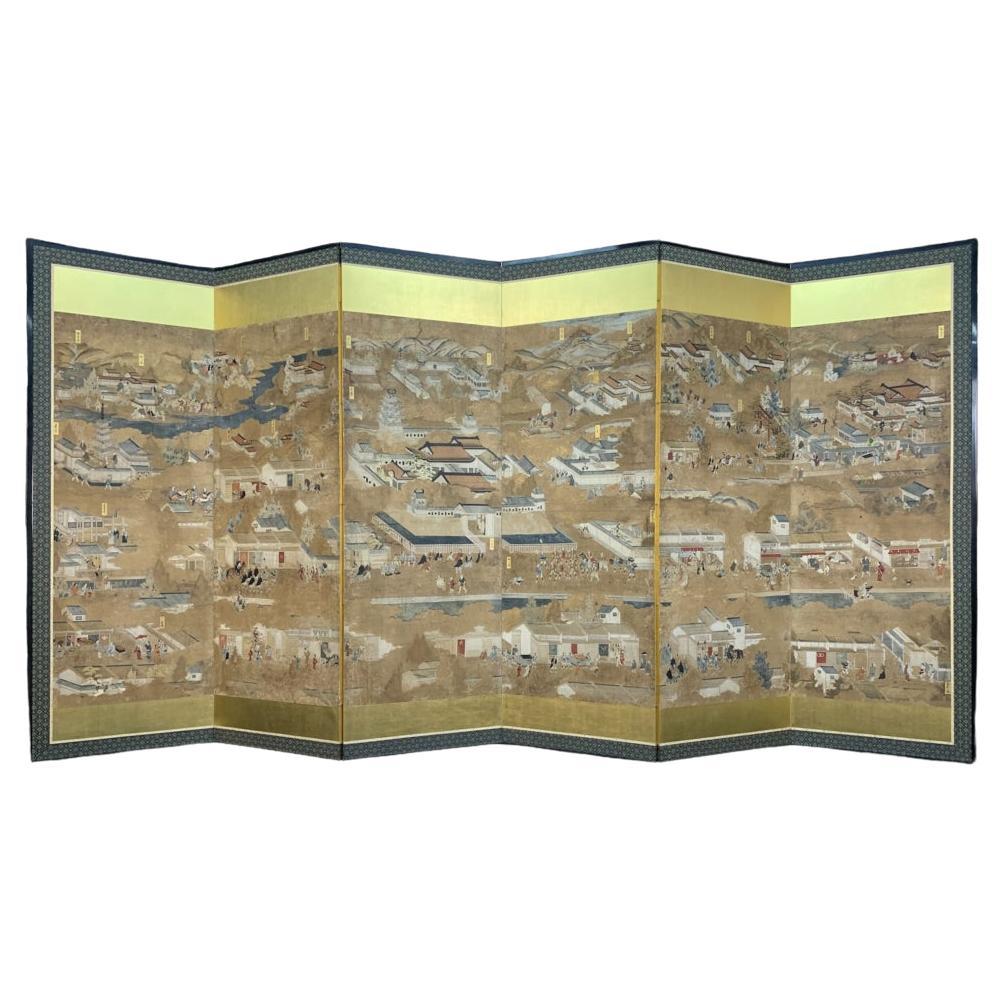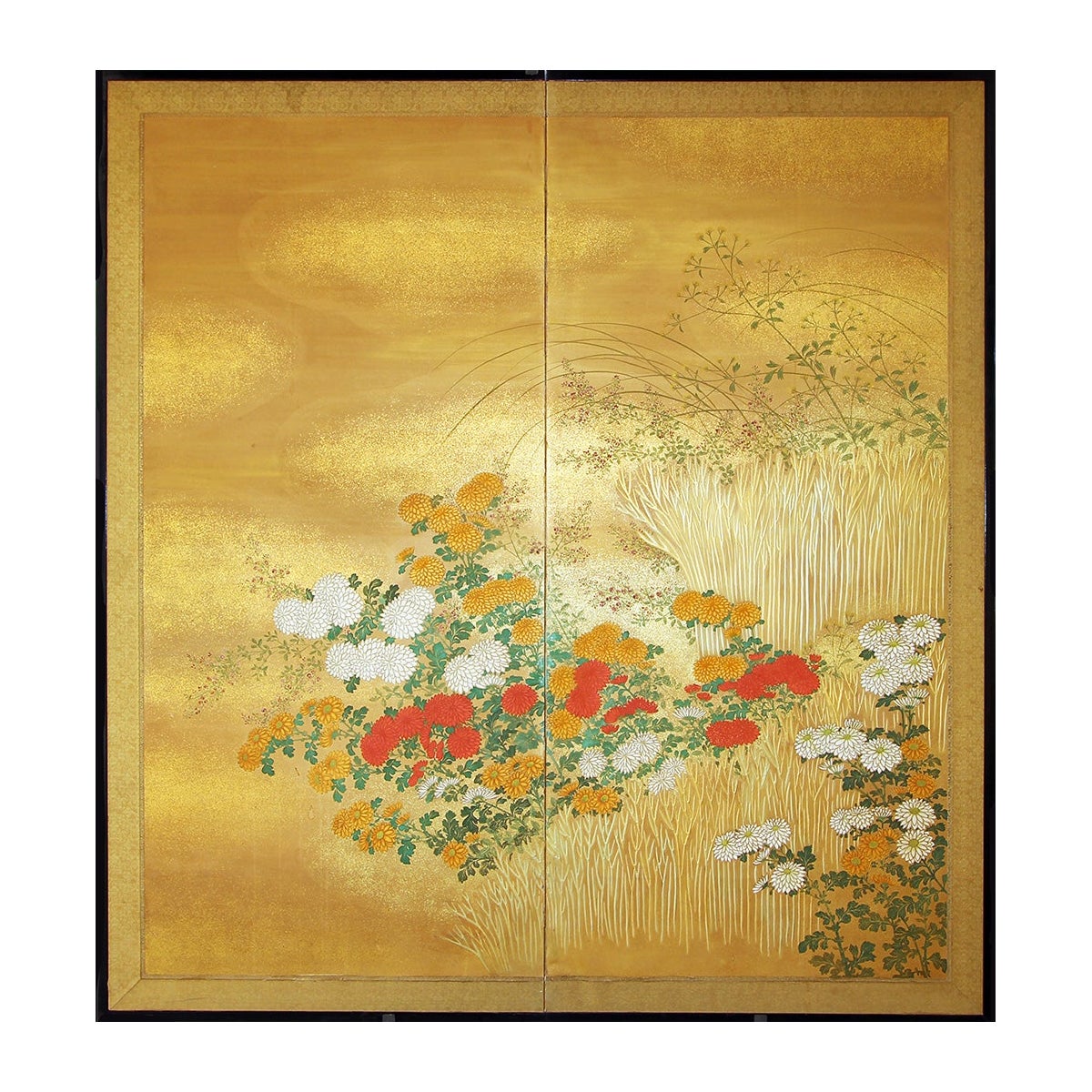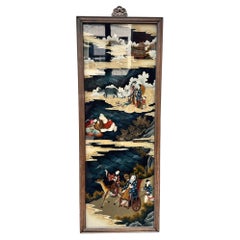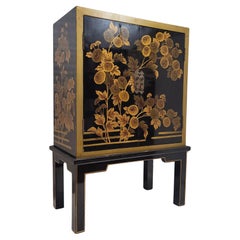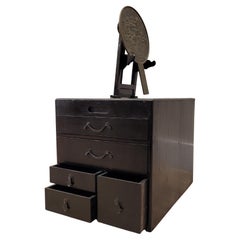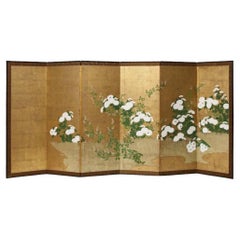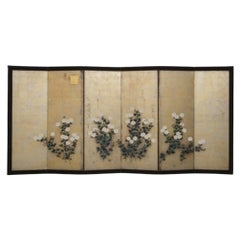
Byôbu Screen 屏風 Chrysanthemums, Rinpa School, Edo / Meiji period
View Similar Items
Video Loading
Want more images or videos?
Request additional images or videos from the seller
1 of 22
Byôbu Screen 屏風 Chrysanthemums, Rinpa School, Edo / Meiji period
$9,453.33List Price
About the Item
- Creator:Rinpu Sasaki (Artist)
- Dimensions:Height: 66.93 in (170 cm)Width: 141.34 in (359 cm)Depth: 0.79 in (2 cm)
- Style:Edo (Of the Period)
- Materials and Techniques:
- Place of Origin:
- Period:
- Date of Manufacture:1880
- Condition:Wear consistent with age and use.
- Seller Location:Valladolid, ES
- Reference Number:1stDibs: LU2943342554622
About the Seller
4.7
Gold Seller
Premium sellers maintaining a 4.3+ rating and 24-hour response times
Established in 1990
1stDibs seller since 2017
159 sales on 1stDibs
Authenticity Guarantee
In the unlikely event there’s an issue with an item’s authenticity, contact us within 1 year for a full refund. DetailsMoney-Back Guarantee
If your item is not as described, is damaged in transit, or does not arrive, contact us within 7 days for a full refund. Details24-Hour Cancellation
You have a 24-hour grace period in which to reconsider your purchase, with no questions asked.Vetted Professional Sellers
Our world-class sellers must adhere to strict standards for service and quality, maintaining the integrity of our listings.Price-Match Guarantee
If you find that a seller listed the same item for a lower price elsewhere, we’ll match it.Trusted Global Delivery
Our best-in-class carrier network provides specialized shipping options worldwide, including custom delivery.More From This Seller
View AllChinese Qing Reverse-Painted Mirror from the Qing Dynasty
By Chow's Oriental Furniture Co.
Located in Valladolid, ES
Stunning reverse-painted mirror from the 19th-century Qing Dynasty, depicting different scenes in a vertical narrative.
Different scenes with symbolic and auspicious elements frame r...
Category
Antique 1870s Chinese Qing Paintings and Screens
Materials
Crystal
Japanese Black Cabinet “Chrysanthemums”, urushi-e lacquer, Showa period
Located in Valladolid, ES
Stunning Japanese cabinet in lacquered wood, original from the Shōwa period. The Shōwa era (in Japanese, 昭和時代, literally "period of enlightened peace") or Shōwa period is the period ...
Category
Vintage 1940s Furniture
Materials
Wood, Giltwood, Lacquer
$2,349 Sale Price
20% Off
Japanese Meiji Dressing Stand with Mirror Black Lacquer
By Vintage Japanese Monochrome
Located in Valladolid, ES
Elegant and beautiful Dressing Table or it could be suitable for a jewellery box , Meiji Period ( 1868 - 1912 ).
Executed with black lacquer, holding a bronze hand mirror ( ekagami)
Configured with five smooth-running drawers of different Size. Two are equipped with slender "hirute"-shaped bail handles and three with decorative pull-rings.
The front-and backside featuring oval grips for easy transport.
Surmounted by a mirror frame in a shape reminiscent of a Shintô shrine torii-gate-
a twin-posted framework with a triangular crossbar flared in upswept Chinese-style gable ( Karahafu) endings.
Resting of the frame is the Japanese traditional handheld mirror with auspicious embossed design of wisteria ( fuji) and lovely patina.
Inscription on the right.
Considering its age the set is in a very good condition with some traces of usage and wear conform age.
Dimensions:
Dressing stand...
Category
Antique 1880s Dutch Meiji Antiquities
Materials
Bronze
$1,644 Sale Price
30% Off
France Oil on panel “Marina”, French School
By French House & Garden
Located in Valladolid, ES
Exceptional painting depicting a Mediterranean seascape. The two fishing boats in the center of the composition stand out. In the far distance, a village with a small harbor, charact...
Category
Antique Early 1900s French Beaux Arts Paintings
Materials
Wood, Giltwood, Paint
Black Table Lamp Bamboo Black Patent Leather Screen
Located in Valladolid, ES
Piece unique, an exceptional table lamp in original bamboo cylinders with bronze finials, 1970. Beautiful black and interior gold patent leather screen in a Hollywood Regency style. ...
Category
Vintage 1970s French Mid-Century Modern Table Lamps
Materials
Bronze
$2,079 Sale Price
32% Off
French Bronze Baroque Bust “Boy”, patinated bronze, François Duquesnoy school
By François Duquesnoy
Located in Valladolid, ES
One of a kind patinated bronze bust of a child on a stepped ebonized wood pedestal,François Duquesnoy school, decorated with tortoiseshell look alike inlays. The bust shows a clea...
Category
Antique 1790s French Baroque Busts
Materials
Bronze
You May Also Like
Late Edo Period Rinpa School Chrysanthemum Blossom Screen
By Rimpa School
Located in Fukuoka, JP
Late Edo Period Rinpa School Chrysanthemum Blossom Screen
Period: late Edo, early 19th century
Size: 364 x 172 cm (143 x 67 inches)
SKU: PTA13
This exquisite late Edo period Rinpa ...
Category
Antique 18th Century Japanese Edo Paintings and Screens
Materials
Paper
Kiku to Hagi Byobu, Rinpa School Style, Edo Period.
Located in Point Richmond, CA
A Chrysanthemum and Bush Clover painting on gold leaf six-panel folding screen, painted with clusters of leafy green chrysanthemum plants with white blossoms having moriage relief petals of gofun growing amidst pink blossoming bush clover within a bunched bush clover garden fence rendered in lighter gold relief, all on a background entirely of rich gold leaf. These two flowers are symbolic of Japan and the autumn season. The classic patterned paper verso with a Naga Antiques...
Category
Antique Early 1800s Japanese Edo Paintings and Screens
Materials
Gold Leaf
“Kiku Byobu”, a six-panel chrysanthemum folding screen, Rinpa School
Located in Point Richmond, CA
“Kiku Byobu”, a six-panel chrysanthemum folding screen, Rinpa School, Meiji Period (1869-1912).
Painted with several variations of white moriage chrysanthemums interspersed with sma...
Category
Antique Late 19th Century Japanese Meiji Paintings and Screens
Materials
Paper
Antique 19th Century Japanese Two-Panel Screen ‘Byobu’, Kano School, Edo Period
Located in London, GB
Japanese Kano School Edo period two-panel screen depicting flowering prunus and bamboo on a rock formation, with colorful birds next to a body of water. ...
Category
Antique Mid-19th Century Japanese Edo Paintings and Screens
Materials
Gold Leaf
18th Century Japanese Rinpa Screen. White Chrysanthemums. School of Korin.
Located in Kyoto, JP
School of Ogata Korin
White Chrysanthemums
18th Century, Edo period.
A two-panel Japanese screen. Ink, color, gofun and gold leaf on paper.
Dimensions: H. 171 cm x W. 188 cm (67.5” x 74”)
On this two-panel Japanese screen we see blooming chrysanthemums, a flower which embodies the essence of autumn in Japan. Here the traditional floral theme has been simplified and stylized. The bright colors and asymmetrical composition against the delicate gold leaf create a luxurious and ornate work of art. Its background, a strikingly patinated grid of gold leaf, denies any sense of place or time and imbues everything with an ethereal glow. The leaves and stems of the plants are nothing more than pools of mottled color and ink without any outline whatsoever. These are typical Rinpa adaptations of traditional ink painting methods; tarashikomi, or diluted washes of color blended while very wet, and mokkotsu, or “bonelessness,” which creates forms without exterior outlines. The relief work of the rounded flower petals has been obtained by the moriage process (a mixture based on ground shells modeled on the surface of the paper).
On the lower right of the screen, the siganture “Hokyo Korin Jakumyo” and the “Hoshuku” seal can be read. Korin is Ogata Korin, famed for the Irises (Nezu Museum) and Red and White Plum Blossom (MOA Museum of Art) folding screens, both National Treasures. Korin worked in both Kyoto and Edo in the mid-Edo period. Korin was using the art name “Jakumyo” just after he received the Hokyo level, which was in 1701.
This particular screen was published in May of 1961 in the Japanese Sansai Fine Art Magazine*. An in depth article accompanies the photograph of the screen and and a photograph of the signature and seal. This article devotes much of its body to discussing the moriage technique, how it enlivens the chrysanthemum flowers and Korin’s specific skill in using the technique. The article goes on to discuss the most famous works of Korin, utilizing this technique, which were known at the time. Specifically a two-panel screen held in the Honolulu Museum which was discovered in the store-house of Takahashi Soan. A two-panel screen pair which the Nakano family own. A two-panel screen pair with chrysanthemums in moriage in fan designs owned by the Nomura family. Also a small folding screen featuring chrysanthemums held in the Yamato Bunkakan. The article goes on to say that this particular two-fold screen came from the Nijo family. Korin is known to have had a strong connection with the aristocratic Nijo family. The article explains that Korin received a lot of favors from the Nijo family and that this screen would have been gifted to them.
Since that time the Honolulu screen has been amended to ‘attributed to Ogata Korin’ and I do not know further details of the other 3 screens. Other Chrysanthemum screens...
Category
Antique 18th Century Japanese Edo Paintings and Screens
Materials
Gold Leaf
Edo Period Rimpa School Golden Screen - Summer Florals
By Rimpa School
Located in Fukuoka, JP
Edo Period Golden Screen - Summer Florals
Period: Edo
Size: 285 x 92.5 cm (112.2 x 36.4 inches)
SKU: PTA141
This Edo period screen is a golden-framed window into the summer gardens...
Category
Antique 18th Century Japanese Edo Paintings and Screens
Materials
Gold Leaf
Recently Viewed
View AllMore Ways To Browse
Hanging Japanese Screen
Chinese Bird Prints
Edo Japanese Screen Kano
Japanese Screens And Doors
Antique Japanese Lacquerware
Dried Flowers Framed
Chinese Gold Leaf Screen
Heian Period
17th Century Japanese Screens
Chinese Wooden Wall Panels
Japanese Screen Chrysanthemums
Antique Folding Fans
Byobu Gold Leaf
4 Panel Chinese Screen
Chinese Woodblock Print
Japanese Folding Fan
Chinese Lacquerware
Chinese Scroll Bird Painting
